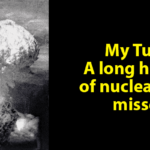by Matt Bivens, M.D.
During my residency in emergency medicine, an attending physician watching me place a central venous catheter spoke up. “Don’t let go of the wire!” he warned.
“Right,” I agreed.
But secretly, I thought, “Why not? It’s not going anywhere.”
I’ve placed easily more than 100 central venous catheters since, and I admit that I some- times let go of the wire. If I’m establishing access to an internal jugular vein, for example, I clean and anesthetize the area, cannulate the vein under ultra- sound guidance, pass a guide- wire through the needle, and confirm by ultrasound that the wire is in the vein. Usually this wire is about 45 cm long, with about two thirds of its length outside the patient. If I let go of it, it just lies there, protruding from the neck, maybe bouncing up and down gently on the sterile f ield. My hands are free to reach for and use the scalpel, the dilator, and the triple-lumen catheter. After becoming an attending myself, I would sometimes remember that mentor and smile at his concern. This wire wasn’t going anywhere.
And then one day, I turned to reach for the scalpel, the dilator, and the triple lumen — and when I turned back, the wire was gone.
Puzzled, I looked more closely and saw 4 cm of wire sticking out from the patient’s neck, then 3 cm. I reached out and pinched the disappearing wire between my gloved thumb and forefinger. Slowly I drew the wire back out. I released it and watched as it slid smoothly back in, until I stopped it again. The wires have a soft U-shaped bend at the end. Maybe in this case the bend was acting like the balloon of a transvenous pacer, f loating the wire into the heart?
Well.
Like a good doctor, I tidily f inished the procedure and com- partmentalized away for later consideration the horror of how close my patient and I had come to catastrophe.
Losing a foot and a half of wire inside a patient is the very def inition of a “never event.” As “never” implies, such errors should not ever be made and are therefore hard to forgive. And yet the never events never stop. A 2015 review estimated that surgical items are unintentionally left inside a patient’s body during 1 in every 10,000 operations.1 According to the Centers for Disease Control and Prevention, there were roughly 1.2 mil- lion cesarean sections in 2017 alone — at 1 in 10,000, that works out to a whole lot of never.
What about my specif ic scenario? Even a cursory review of the literature reveals multiple cases of clinicians losing a venous catheter guidewire.2-5
Take, for example, a case several years back in China, in which a catheter wire showed itself months after the operation, as a length of elastic metal sticking jauntily out the back of the patient’s neck.4 Or a report from Iran, in which the authors bemoaned a wire adrift in the chest that was discovered on an x-ray as a “totally preventable” human error.5
I share the Iranian authors’ dismay. But “totally prevent- able”? Hardly. Despite all our efforts — the bar-coded wrist- bands, the time-outs, the hard stops in the computer — everyone in medicine knows the never events will keep coming.
The wrong teeth will be pulled and the wrong kidney biopsied, the wrong type blood transfused and the wrong ovary removed. ECGs will be misread, fractures will be missed, catheter guide wires will be lost. New- borns will be discharged home with the wrong family (the Joint Commission documented one such case in 2016).
The inevitability of never events is deep knowledge in the medical profession. And it’s time we shared this knowledge with the world outside medicine and addressed the largest never event of all — a nuclear war.
If the United States or a foreign government announced tomorrow that it had armed itself with a terrible new gas, a cloud of which could instantly vaporize a city, we would all recoil in outrage. Yet the only difference between such a hypothetical gas and a very real nuclear weapon is that chemical weapons have been universally condemned and banned under international law.
Offering the moral case against a genocidal weapon is a traditional role for a doctor, and I can play the pious scold with the best of them. I can point out, with relish, that detonating a nuclear explosive on a foreign city could mean incinerating every kindergarten, every neonatal and pediatric intensive care unit. I can make that point be- cause, as visceral and upsetting as it is, it’s true. If a doctor can’t tell it to you straight, who can?
But when physicians question not just the morality of nuclear war, but also the competency of the planners, we are admonished to stay in our lane. “Be a doctor. Explain the potential suffering. But don’t question whether military planners understand their jobs.”
And yet I do question the planners. Because I know from experience that it is impossible to eliminate never events.
Anyone involved in acute care medicine has stories of days when good intentions slid horribly sideways. So do U.S. nuclear-war planners, who once dropped two nuclear weapons on North Carolina after the plane carrying them broke apart; once dropped four nuclear weapons on Spain when an- other plane crashed; once spent 6 panic-f illed minutes preparing to launch a nuclear war before they realized they were respond-ing to a training simulation; and more than once had to work around a president who was belligerent and intoxicated.
The only way to eliminate never events from a complex system is to eliminate the system. We can’t eliminate health care, and so we must, with dogged resignation, put our faith in fail-safes. We follow checklists, use closed-loop communication, and keep one hand on the guide wire.
But we can eliminate nuclear weapons, by banning them under international law, as the United Nations voted to do in 2017, and dismantling them, as we’ve done with chemical and biologic weapons. I believe physicians should be natural sup- porters of efforts such as “Back from the Brink” (w w w.prevent nuclearwar.org), a grassroots campaign that calls for the United States to take f ive steps to lead the process of rapid global nuclear disarmament. The campaign’s resolution has been endorsed by cities including Salt Lake City and Baltimore and by major environmental groups and medical societies, and a ver- sion of it has been introduced in the U.S. House of Representatives for consideration. Physicians for Social Responsibility, on whose board I serve, has also endorsed the resolution. At its core, this initiative recognizes that nuclear war, the ultimate never event, is a catastrophic inevitability — unless we eliminate nuclear weapons arsenals themselves.
Disclosure forms provided by the author are available at NEJM.org.
From the Department of Emergency Medicine, Beth Israel Deaconess Medical Center, and Harvard Medical School – both in Boston.
1. Hempel S, Maggard-Gibbons M, Nguyen DK, et al. Wrong-site surgery, retained surgical items, and surgical f ires: a systematic review of surgical never events. JAMA Surg 2015;150:796-805.
2. Schummer W, Schummer C, Gaser E, Bartunek R. Loss of the guide wire: mishap or blunder? Br J Anaesth 2002;88:144-6.
3. Auweiler M, Kampe S, Zähringer M, et al. The human error: delayed diagnosis of intravascular loss of guidewires for central venous catheterization. J Clin Anesth 2005; 17:562-4.
4. Guo H, Peng F, Ueda T. Loss of the guide wire: a case report. Circ J 2006;70:1520-2.
5. Khatami MR, Abbasi R, Sadigh G. Guide wire migration during femoral vein catheterization. Iran J Kidney Dis 2010;4:333-5.


